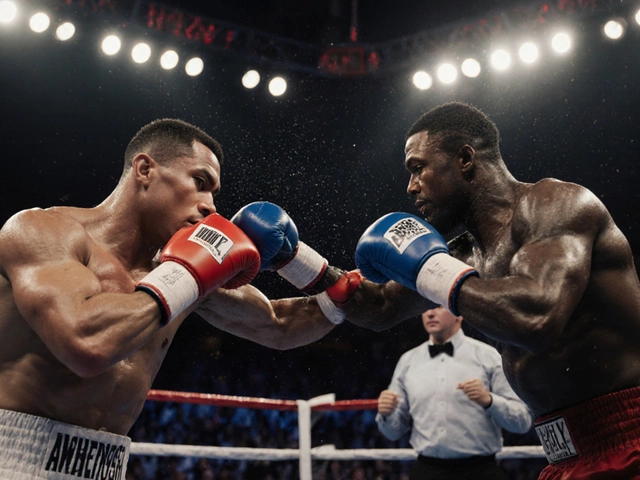You're watching a close boxing match, the bell rings, and you see the scorecard pop up: “10-9, 9-9…” and then your mind whirls. What does that '9' actually mean? Did someone mess up? Or does it actually say something about the round? If you’ve ever squinted at a boxing score and wondered why a fighter didn't get a 10, you’re not alone. The way points work in boxing can seem like some strange, secret math. But the '9' tells us a lot more than most people realize—about the fighters, the round, and even the judge’s perspective.
How Does Boxing Scoring Actually Work?
Boxing matches usually get scored using that familiar 10-point must system. So here's how it goes: the winner of each round must get 10 points (unless there's a penalty or knockdown). The other guy gets a 9, or sometimes less if things really didn't go his way. So, when you see a '9' next to a boxer’s name for a round, it means he lost that round—at least in the eyes of that judge. Simple, right? But there are so many situations and shades of gray that most people overlook when watching this all play out live.
Let’s get specific. Each round is a mini-battle. The judge scores how effective each fighter was—clean punches, technique, ring control, aggressiveness. The winner gets a 10. The loser gets a 9, unless he was knocked down or badly beaten, in which case he could get as low as an 8. In the rare event of a draw—a truly even round—both get 10. But that almost never happens, because boxing doesn’t reward indecision. Judges usually lean one way or another, even if just a bit.
But here’s the key: getting a 9 isn’t the end of the world for a boxer. It just means he came up short that round, maybe by a hair. Sometimes a boxer gets a 9 despite putting on a decent show, just not quite as good as his opponent. And since fights go over several rounds—anywhere from 4 to 12—a single '9' isn’t a knockout blow on the scorecard, but a signal to the boxer and his corner that they might need to step it up.
If you look back at fights—like that razor-close 2013 war between Timothy Bradley and Juan Manuel Marquez—scorecards filled with 10-9 rounds tell the real story: judges saw many rounds as close, not landslides. In most cases, you’ll see far more 10-9 than 10-8 or other weird numbers because boxing is a sport of thin margins.

Why Do Fighters Get a 9? Breaking Down the Numbers
Getting a '9' in boxing isn’t shameful. Let’s face it: sometimes a round is lost just by a couple of cleaner shots, a split-second mistake, or maybe the other guy just had more energy. Scores of 10-9 are the backbone of boxing scorecards. They show that a round was competitive but one fighter did just enough to edge ahead. Rounds don’t have to be blowouts. In fact, most pros spend their careers racking up more 9s than 10s unless they’re absolute superstars.
So, what actually causes a fighter to get a '9'? Most commonly, it’s a round where he was simply outboxed, maybe by a little or a lot. Maybe the boxer was passive, maybe he landed fewer clean strikes, or maybe he got pushed around the ring. If it’s close, the judge still has to pick a winner for the round—someone’s getting a 9 just by the rules.
Now, boxing has a reputation for subjectivity. Different judges look at different things. Some love clean combos, others reward constant pressure, and a few care more about ring control. That’s why, especially in tight matchups, fans go wild debating: “Was that really a 10-9 round? Or should it have been 9-10?” The rules say the round winner must get a 10 (unless penalized) and the other gets, at best, a 9.
Take a look at the table below for a quick breakdown of how scores usually shake out in each type of round:
| Situation | Typical Score |
|---|---|
| Clearly won round | 10-9 |
| Knockdown occurs | 10-8 |
| Two knockdowns or a dominant beating | 10-7 |
| Extremely close, could be a tie | 10-10 (rare) |
| Deductions for fouls | Points subtracted as needed |
The 9 becomes a mark of so many rounds that are competitive, but not decisive. And if you see a run of 10-9 rounds over a fight, you’re watching two evenly matched boxers. If you see lots of 10-8s? Somebody’s having a rough night. But it’s the 9s and 10s that really stretch out over every classic title fight.
Ever hear boxing commentators say, “That’s a swing round”? It usually means the winner just did a pinch more, so the score nudges to 10-9 in his favor—but that’s where the drama comes in, and where fans and fighters sometimes question the judges. There's a certain tension in every '9' that makes boxing unpredictable and keeps everyone guessing till the very end.

What Does a 9 Tell Us About the Fight?
Dig into the details, and a '9' can actually be revealing. It’s not just a number; it says something about tempo, tactics, maybe even momentum. In tight fights, getting a consistent stream of '9's can mean one guy is always just a step behind—or maybe just unlucky with the judges. There’s real psychology at play: see enough '9's on your side, and you might feel heat to push harder, protect yourself less, or gamble on big power shots to flip a round.
Analyze Canelo Alvarez’s fight history, you’ll notice most rounds that he “lost” were scored as 10-9. Rarely do you see him get an 8 or lower, simply because he almost never lets himself get totally dominated. The 9s hint that he wasn’t the aggressor, or he took a defensive approach, letting the other guy shine a little more. Sometimes, that’s even a strategy: conserve, wait for those late rounds, and pile up 10s when the other guy slows down.
The scoring system also helps explain why upsets can happen. If a fighter is used to getting '10's and suddenly starts piling up '9's, it can shake his confidence. Corners study those numbers between rounds, using them to plan comebacks or urge fighters to take more risks. It’s wild how a single digit can fuel or crush an entire game plan.
This whole process is why judges and scorecards can spur fights among fans. Nobody likes seeing their favorite boxer eat a few too many '9's—especially when the action felt dead even. Boxing is packed with controversy for this reason: one judge might favor flashy combos, another head movement, and another values clean, effective jabs. You’ll see each '9' explained, debated, and sometimes even protested after major title fights.
Here’s a quick tip: If you want to score a fight yourself while watching, jot down who you think won each round—give them a 10, and the other a 9. Does your final tally line up with the pros? Try it with classic fights, like Hagler vs. Leonard, and see why people still talk about controversial '9's decades later. It really drives home how each round (and each 9) matters in both the match and its history.
Boxing scorecards may look technical, but each number—especially the humble 9—drips with meaning. It shapes the fight, the fighters, and those electrifying moments when a close bout is up for grabs. So next time a '9' flashes on the screen, you know it’s more than a mark—it’s a clue.




